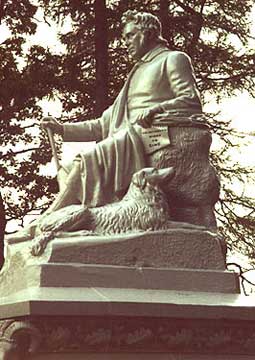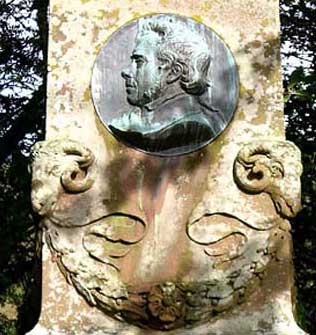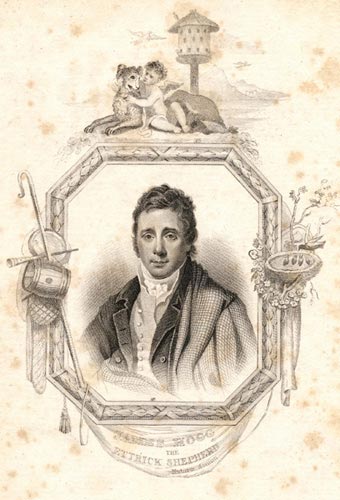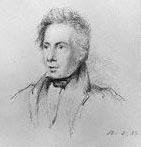

![]()
JAMES HOGG, THE ETTRICK SHEPHERD
PART I: SHEPHERD & FARMER

Statue by Currie, of James Hogg with his sheepdog, Hector,
at St. Mary's Loch, southwest of Selkirk in the Borders of Scotland.
(Photo by Ellie Green.)
Without the shepherd's dog, the whole of the open mountainous land in Scotland would not be worth a sixpence. It would require more hands to manage a stock of sheep, gather them from the hills, force them into houses and folds, and drive them to markets, than the profits of the whole stock were capable of maintaining.--James Hogg, 1824, from The Shepherd's Calendar

The portrait of James Hogg on the memorial to James Hogg
at his birthplace in the village of Ettrick in the Borders of Scotland.
A plaque reads: "Erected on the Site of the Cottage in which
James Hogg The Ettrick Shepherd was Born 1770-Died 1835
The Edinburgh Border Counties Association 1898."
(Photo by David or Carole Presberg, October 2006.)
Like no other literary figure, James Hogg, known as "the Ettrick Shepherd", had an appreciation of the role played by the shepherd's dog in the sheep industry in Scotland. The above is most often quoted by modern writers as a measure of the sheepdog's worth, but throughout his writing Hogg indicated that he had a very high opinion of the usefulness of this type of dog, and once said:
A shepherd may be a very able, trusty, and good shepherd, without a sweetheart--better, perhaps, than with one. But what is he without his dog?
And who knew better than he?
 Left, an engraving of James Hogg by W.T. Fry after a painted portrait by William Nicholson (1781-1844).
Left, an engraving of James Hogg by W.T. Fry after a painted portrait by William Nicholson (1781-1844).
James Hogg was born the second son of Robert Hogg and Margaret Laidlaw in the
parish of Ettrick in the Borders of Scotland in 1770. In his Memoirs of the
Author's Life, Hogg said "my progenitors were all sheepherders of this country. My father, like myself, was bred to the occupation of a shepherd." His ancestors had been small farmers, but by the time of the poet's birth their fortunes had declined. His father became a dealer of sheep and a drover, but when the price of sheep dropped drastically, he went bankrupt and became a tenant farmer.
Hogg's mother was renowned as a ballad teller and was 40 when he was born. She brought her children up on the tales of the countryside where they lived. James hired as a cowherd at the age of 7, taking for his half-year wages, a ewe lamb and a new pair of shoes; and he had then "an excellent dog". By the time he was 15 he had served dozens of farms as shepherd, and at the age of about 20 he became herd to the Laidlaws of Blackhouse in the Yarrow Valley, and served them for 9 years.
 Right, a portrait of James Hogg by William Brockedon (1787-1854).
Right, a portrait of James Hogg by William Brockedon (1787-1854).
Mr. Laidlaw was like a father to Hogg, and the educated world in which his family lived was opened to his young hired shepherd. It was during this time that Hogg began to write poetry when out with his flock whenever he found some spare time. He was greatly influenced by Burns, whose poems he first became acquainted with in 1797, the year after Burns died. Apart from brief periods of employment in Dumfriesshire, and the five years he lived in Edinburgh pursuing his literary career, Hogg spent his entire life as a farmer and shepherd in the valleys of Ettrick and Yarrow. In 1820, when he was 50 years old, Hogg married Margaret Phillips, and for the remaining fifteen years of his life lived in the Yarrow valley.
While the name of James Hogg, the Ettrick Shepherd, may be familiar to most people interested in sheepdogs, and they have undoubtedly seen the quote that opens this article many times, how many are acquainted with James Hogg the literary figure or with the bulk of his writing? In her introduction to A Shepherd's Delight: A James Hogg Anthology, Judy Steel says: "The range of Hogg's work never ceases to amaze me. Poet and songwriter--he himself wished to be seen as the heir to Burns--he was also a novelist, short story writer, essayist, and journalist. His enthusiasms spilled over into music (he played the fiddle and the flageolet) and into sport...[and] in the Hawick [Scotland] Public Library [are] two volumes of his plays."
Although he continued to pursue a pastoral life at the same time as his literary career, Hogg's farming and financial ventures were never very successful. He was better at writing about the land than making a living from it, and sheepdogs were very often favorite subjects. Many of his tales of shepherd's dogs appeared in The Shepherd's Calendar (1829, William Blackwood, Edinburgh), many of which originally appeared previously in Blackwood's Edinburgh Magazine. One of my favorites is the following tale about Hector:
[Hector] rarely missed aught that was said about himself, the sheep, the cat, or a hunt...There was one winter evening, I said to my mother that I was going to Bowerhope for a fortnight..."But I will not take Hector with me, for he is constantly quarrelling with the rest of the dogs..."
"Na, na," quoth she, "leave Hector with me; I like aye best to have him hame, poor fellow."
These were all the words that passed. The next morning the waters were in great flood, and I did not go away till after breakfast; but when the time came for tying up Hector, he was wanting...
The Yarrow was so large as to be quite impassable, so that I had to go up by St. Mary's Lock, and go across by the boat; and on drawing near to Bowerhope, I soon perceived that matters had gone precicely as I suspected. Large as the Yarrow was, and it appeared impassable by any living creature, Hector had made his escape early in the morning, had swum the river, and was sitting, "like a drookit hen," on a knoll at the east end of the house, awaiting my arrival with great impatience.
Copyright 2008 by Carole L. Presberg
Please go to James Hogg, the Ettrick Shepherd,
Part II: Of Shepherd's Dogs
Back to Introduction to James Hogg
Back to

the Border Collie Museum
THE OTHER WEB PAGES WE MAINTAIN
These web pages are copyright ©2013
and maintained by webmeistress Carole Presberg
with technical help from webwizard David Presberg
ALL RIGHTS RESERVED
If you are interested in using ANY material on this website, you MUST first ask for permission.